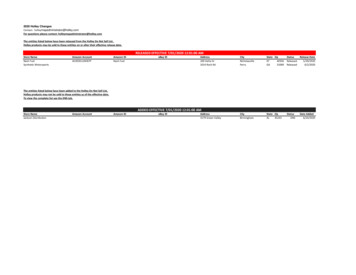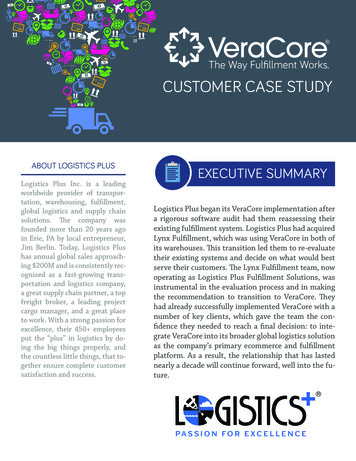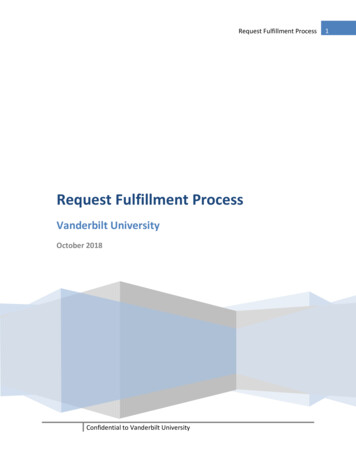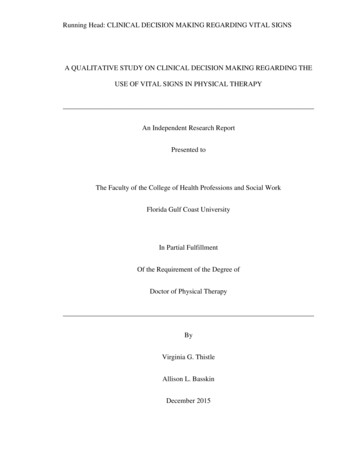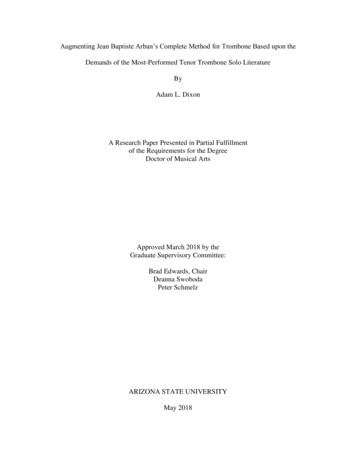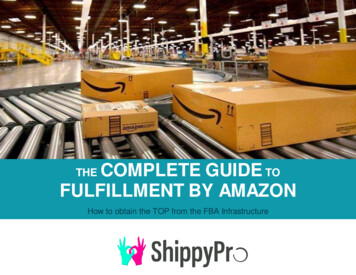
Transcription
COMPLETE GUIDE TOFULFILLMENT BY AMAZONTHEHow to obtain the TOP from the FBA Infrastructure
IntroductionAmazon helps businesses reach more customers thanever before and has one of the most advancedfulfillment networks available in the world.It’s important for sellers to understand the significance ofFulfillment by Amazon and how leveraging Prime canimpact their sales performance.FBA is considered one of the most influential leversthird-party sellers can utilize to improve Marketplaceperformance and get ahead of their competitors, butwithout a proper FBA analysis, many sellers will seetheir profitability fall short of projections.FBA can actually be used for fulfillment on channelsoutside of the Amazon Marketplace (ex. the seller’s site,eBay, etc). Many Shippypro.com customers use FBA tomanage logistics and shipping of all their products, whileusing Shippypro’s dashboard to keep under control all theorders received from different channels, so that they caneasily communicate to Amazon which product has to beshipped where.
Amazon sellers, FBA and FBMAmazon has shown to be one of the world largest and more complex marketplaces in theworld.Amazon seller have to compete with millions of other sellers, while managing all theprocesses connected to selling and shipping.Amazon offers two solutions: you can choose between FBA and FBM process. Your decisionwill impact all your online business.WHAT DO WE MEAN WITH FBA AND FBM?We started to talk about two solutions, but what do FBA and FBM mean?FBA means “Fulfillment by Amazon”: Amazon offers to its sellers the possibilità of managingtheir inventory, shipping and customer care.Sellers using FBA service ship their products to Amazon fulfillment center, where productsare stored until a new order arrives. Once received the new order, the product will be packedand shipped directly from Amazon.FBM means instead “Fulfillment by Merchant”: acompletely different situation. In FBM all the inventory,stock and shipping are managed by the seller.The seller uses his own resources to manageprocesses, and he is completely responsible of all thephases.After this short definition of Amazon FBA and FBM, let’sanalyze better this two processes.
FBAIn four words, FBA works this way: You sell, Amazon ships.In detail, Fulfillment by Amazon is developed in this way:The seller directly sends his products to Amazon fulfillment center, products are registeredand storedAmazon manages the inventory and the seller can monitor the movements of his productsusing a tracking numberWhen a buyer makes an order, on Amazon.com or from other sources, the product stored inAmazon inventory is packedIn FBA the and Amazon staff manages customer care and returnsFBA doesn’t work only for orders made on Amazon.com but also for orders coming from othermarketplace or for the seller’s website. Many Shippypro customers use FBA to managelogistics and shipping of all their products, while using Shippypro’s dashboard to keep undercontrol all the orders received from different channels, so that they can easily communicate toAmazon which product has to be shipped where.Amazon keeps the inventory for all selling channels, and it manages the orders in an uniquecenter.One of the main advantages of being a FBA seller, it is surely that products become Primeproducts, shown before the others. Entering into this category, we can gain customers andorders received, also because Prime member usually make more orders.FBA sellers have a higher probability of winning the BUY BOX. Buy Box accounts for 82% ofAmazon sales: everybody wants to know how to win the buy box.
Another advantage is that FBA seller’s customers will have free shipping in 48 hours providedby Amazon, and overnight delivery for 3,99 . Thanks to this opportunity many sellersincreased thei sales by 25%.Added to these advantages, sellers have nothing to manage in the after sales phase. Theonly thing to do is to ship their products to Amazon fulfillment center, and to pay amonthly/annual fee to Amazon.FBA sellers usually obtain higher conversion rate: that’s because their product is consideredas if it was sold directly from Amazon. This impression gives a sense of trust to the customer,as Amazon is one of the most reliable trademarks in the world.Moreover, in case your products are delivered late or some other delivery problems happen,Amazon is fully responsible. Negative feedbacks will not affect the seller reputation.FBA makes the process easier, especially for sellers managing high volumes of sales.Of course, FBA has not only positive aspects, but even some flaws.1- In case the sellers choose FBA, he will face addictional costs that will affect their finalprofit. In fact, FBA seller will pay not only the FBA fee but even the shipping costs to thefulfillment center.2 – Another flaw is that Amazon asks to be paid for every cubic feet of space occupied in thestorehouse. This is a problem, especially for the “long-tailed products” which have longstoring time.3- Multichannel can be costful and inventory can be difficult to be traced.4- Many sellers don’t want to put all their inventory into Amazon’s hands.5 – Last but not least, the seller’s performances could be affected by problems and mistakesdue to external logistics management: late deliveries, damaging, lost items.
COSTS FOR USING FBAAfter exploring Pros and Cons of being a FBA seller, let’s see better the costs.Comprehension of FBA fees can help us to understand if FBA could be the right decision forus or not.Amazon asks for fees basing on the product type: media (e.g. CDs), non-media (e.g. phonecases), oversize items (e.g. furniture), and then zero fee fulfillment ( 300 software).For our articles, Amazon FBA has this costs:Orders managementPick & Pack for every unit orderedManaging (based on lbs) per unitStoring per cubic feet per month (fees change in different periods of the year)Moreover, there are other cases in which Amazon will apply additional feed. For example, inthis cases we will have a change in standard prices:Oversize products have special shipping costsItems stored in the warehouse for more than six months have additional storing feesStoring fees are different in different period of the year: cost per cubic feet will be higher in theperiod from October to December.After analyzing FBA, and all the costs connected to FBA, let’s see FBM. If you want to getdeeper into FBA, here you can find a good guide!
FBMIf you don’t want to use FBA, we will choose the Merchant process, Amazon FBM.Some sellers prefer to mantain the control over all the selling process.Without paying FBA fees they can increase their profit margins. Usually, FBM sellers obtainhigher profit margins than FBA sellers.Moreover, being a FBM doesn’t exclude you from entering to Prime products. It will just bemore difficult: the sellers will have to avoid late deliveries, provide a perfect customer care,immediate confirmation and shipping of the order and have very good feedbacks. For FBMsellers is very important to reduce shipping costs: while Amazon manages very high volumesobtaining low prices for the fast delivery, FBM will have to compare prices and services of thedifferent couriers, in order to get the best service at the lowest price.Of course, FBM too has some flaws. If we have to manage high volumes it could be difficult tohave an adequate process. We will have to guarantee that our processes perform at the topevery day, without interruptions.FBM sellers don’t have a “free pass” to Prime: they will have to work a lot to get it, and it is notsimple at all.Nothing to see with the Buy Box: the path to access it is even more difficult. We have tosucceed in managing customer complaints and delivering without any delay to have thepossibility to win the most desired buy box across the internet.
Why is FBA a Big Deal?Perhaps the most obvious beneficiaries of FBA are small business owners, who likely don’t haveefficient fulfillment systems in place and don’t want to risk the potential negative effects that apoor customer experience could instigate. For this reason, Amazon is a very favorable businesspartner.Yet professional Amazon sellers see the bigger picture, namely:FBA inventory’s eligibility for Amazon PrimeIts influential role on Buy Box ownershipThe added safeguard for other significant Buy Box factors like Fulfillment Latency andSeller RatingThe benefit that FBA represents a seller’s brand in a more positive light. There is a verystrong correlation between FBA utilization and higher sales performanceWhile there are a good amount of professional Amazon sellers who FBA 100% of their inventory,this isn’t to say that every third-party seller should do this. One of the goals of this white paper isto paint FBA as a very immediate, strategic tool sellers should deploy only for the listings itmakes sense for.A common misconception is that sellers should either be 100% FBM or 100% FBA, yet mostprofessional Amazon sellers are an FBA/FBM hybrid. Not every product a seller offers will be agood candidate for FBA for a variety of reasons, mainly size, sales performance, and margin.Knowing which listings it makes sense for is called FBA inventory selection, and this will becovered later in the guide.
Why Is the Buy Box So Important?The Buy Box is the single most essential piece of “property” on the Amazon marketplace.With 82% of Amazon website sales going through the Buy Box, and an even larger figure inAmazon mobile sales, the Buy Box is seen as the key opportunity for online marketplace sellerstoday to increase their selling potential.It is crucial for sellers to learn about how the Buy Box works and how Amazon determines who“wins” this coveted spot.So what motivates Amazon when it comes to choosing who wins the Buy Box? Simply put,Amazon will always favor offers that are most customer-friendly and consequently, the mostlikely to be purchased.Amazon prides itself on the company’s extremely high levels of customer service. In fact,Amazon’s whole essence focuses around offering the best possible experience to theircustomers.It is for this reason that the Buy Box was created with the objective of comparing multiple offeringsof the same product in order to determine which will provide the customer with the highest levelsof satisfaction. To Amazon, this means the offers with the best price, fulfillment method, sellerrating, etc. The Amazon Buy Box winner is determined by an algorithm that aims to give thecustomer the best possible value.It does this by first determining which product offering meets all the necessary minimumrequirements. It then breaks down each eligible offering into many different variables and usesthem to find the seller who offers the best balance between high seller performance and low costprice.
7The overall number of page conversions occurring on the product detail page(e.g. increasing from 100 to 150 total orders)It’s very possible that plenty of shoppers are landing on this product detail page but don’t endup purchasing the product for a number of seller related or product-page related reasons,including a short product description, undescriptive feature bullets, or a lack of productreviews.By improving the factors that influence conversions on the product detail page, a seller caneffectively convert a higher percentage of the overall number of sessions to a product detailpage.Their percentage of the Buy Box (e.g. increasing it to 75%.)Since the Buy Box winner stands a higher chance of making sales than any other seller, the higherthe seller’s share of the Buy Box, the higher the number of orders they will make. This is mosteffectively accomplished by increasing Buy Box ownership share.
How to Avoid Long Term Storage FeesA semi-annual Long-Term Storage Fee will be applied to any units that have been stored in anAmazon fulfillment center for six months or longer.Units that have been in an Amazon fulfillment center for six to 12 months as of the InventoryCleanup date will be charged 11.25 per cubic foot. Units that have been in an Amazonfulfillment center for 12 months as of the Inventory Cleanup date will be charged 22.50 per cubicfoot.The Long-Term Storage Fee is in addition to the regular Inventory Storage Fee and will not becharged if a removal order has been created to remove or dispose of the units prior to the feebeing charged.Each seller may maintain a single unit of each ASIN in its inventory, which will be exempt from thesemi-annual Long-Term Storage Fee.Why Does Amazon Charge FBA Long Term Storage Fees?According to Amazon, inventory that is overstocked or stored indefinitely in their fulfillment centerslimits their ability to provide space for fast-selling products customers want. The Long-TermStorage Fee program helps ensure that they can continue to provide high levels of service to allsellers and provide customers with products that they want.Amazon doesn’t anticipate sellers will store merchandise in Amazon fulfillment centers for longperiods of time, but in the event this does happen―sellers can suffer greatly at the expense ofthese high additional costs. There is a cost for long-term storage space, and that cost is not builtinto their monthly storage cost structure.
1. Discover Which Products Are at Risk for FBA Storage FeesThe first step for retailers to avoid extra fees is assessing their FBA inventory to determinewhich products are at risk for accruing long term fees.Amazon sellers can access the Inventory Health report prior to an Inventory Cleanup date toestimate the number of units that are susceptible to long term fees within the fulfillment centersfor six months to 12 months or for 12 months or longer.According to Amazon, these units would be subject to the Long-Term Storage Fee (minus anyunits that sell before then).When calculating Fees in the Profitability Analysis, sellers should be aware that:FBA fees are not calculated off the price of an item.If sellers are over 30% in feed, they should be increasingly aware of their marginsFee is unit based (this will differ across catalog), so ASIN-level approach is requiredYou can access the Inventory Health report in Seller Central (sign-in required) by going toReports Fulfillment Inventory Inventory Health and requesting a download.
2. Increase Sales Velocity Through Pricing StrategySome sellers might be wondering if it’s a good idea to invest the time to reprice and try to sell theirproducts prior to August 15th?Repricing is really powerful. It has to be the right competitive landscape for it – you might belimited by MAP or by your margins. Assuming you have a handle on all those factors, repricing isdefinitely a way to increase that velocity.3. Request a Removal Order to Avoid FBA Storage FeesThe Recommended Removal report provides an interface in a seller’s account to more easilyidentify and remove units that are at risk of being assessed the Long-Term Storage Fee.This report will auto-calculate on an ASIN-by-ASIN basis the amount of units you need to remove(assuming no further sales of your inventory) to avoid the Long-Term Storage Fee and will prepopulate a removal request for those units if you choose to remove them.The report only shows units that are at risk of being assessed fees within six weeks of eachcleanup date.You can access the Recommended Removal report in Seller Central (sign-in required) bygoing to: Reports Fulfillment Inventory Recommended Removal and requesting adownload.Once that removal order is in your account, Amazon will exclude that inventory from your long termstorage fee. They will try to send those orders back to you in bulk. So that inventory can actuallytake a week to two weeks to get back to you, depending on how much you are requesting.
The Pros & Cons of FBA
The Pros & Cons of FBAThe decision of whether or not to fulfill through Amazon should not be made on a whim.Sellers must evaluate many different factors in their decision making process, since what may beright for one seller may not be the correct way to go for another. Sellers may also decide thatsome of their products may be suitable for FBA but others are more appropriate to fulfillthemselves. The selling points to FBA are many.The ProsConvenienceFBA relieves the seller of a potentially large headache. Amazon’s fulfillment centers store theseller’s products and do all the legwork for them. When an order is received, Amazon’semployees pick, pack and ship the products, plus they’ll deal with all the customer servicequeries and returns.EligibilityWith FBA, a seller’s products are eligible for Super Saver Shipping, Amazon Prime and Buy BoxEligible status, which all lead to a higher conversion rate.
The Amazon ReputationMany believe that customers are more likely to buy from a seller who has the Amazon nameattached to them. This is due to the strong level of trust that the company inspires in them. Ifsomething goes wrong, people know that Amazon will take care of it. They also know Amazon hasmastered the distribution process and will send the item quickly.Sales PerformanceThere’s also the argument that FBA sellers can sell more because they have the Amazon nameattached to them. For example, let’s say a seller has 10 boxes of coffee and is selling them fromhome at 42 8 for shipping. They would have to go to the post office and pay to ship each saleindividually, including the materials to put the coffee in.On the other hand, if they were selling FBA, they could ship all the boxes to Amazon in one goand then list them at 50 each with free shipping. So the cost to the customer would be the same,but as an FBA seller, they would be making more profit.
The ConsFeesUsing FBA can be extremely costly, particularly for large products. Oftentimes a seller mayhave the manpower and willpower to be taking care of certain elements themselves, soswitching to FBA could hike their costs up.However, as noted earlier, using FBA doesn’t necessarily mean that a seller will be expensing moreto be able to sell a product on the Amazon Marketplace. FBA fees are in place of a seller’s normaloperational and fulfillment costs.ComminglingWhen using FBA, Amazon’s fulfillment centers will ask that the seller identifies their productsusing unique product identifiers.Commingling inventory is essentially the process of pooling Seller A’s units with Seller B’s units ofthe same UPC at an Amazon fulfillment center.If a seller chooses not to label their inventory, commingling is a potential con for FBAbecause fake products from other sellers can enter the mix.This opens the door to the possibility that a customer purchases a product from you andreceives the fake version from another seller―a high risk for products like sunglasses.Other risks include the product from another seller being damaged or faulty. However, there aresome upsides to embracing commingling.
The “It Depends”While there are obviously both clear advantages and disadvantages to FBA that may sway aseller in either direction, the discussion is actually a lot less straightforward and the followingmust be taken into account by each seller considering FBA.It Depends What You SellAlthough some of the fees associated with FBA change according to product size and weight, thepick & pack handling fees are fixed. Therefore, if items tend to be relatively small, not too heavy,and sell at higher prices, it makes the FBA fees more manageable.For example, a 10 item that is large and heavy will represent a large percentage of your margin,whereas the fees for a small and light item that sells at 30, will represent a much smallerpercentage. For this reason, high ASP (average sale price) is a big consideration for FBA inventoryselection.Popular items that sell quickly are also great for FBA. It does not make sense to send something toAmazon that isn’t likely to sell and may languish in storage, racking up storage fees. While somesellers dispute this by claiming that low sales rank items are ideal to sell via FBA, since theirchances of selling usually go up quite a bit due to their Amazon Prime “teaser,” it’s a high-risk movethat makes a seller vulnerable to very costly storage fees. As a side note, sellers should be awareof the fact that storage fees increase during busy periods like Q4.
It Depends How Much You SellFor high-volume sellers, physical storage space could be an issue which FBA would solve. Thehigher the turnover rate for your inventory, the more storage space Amazon will grant you.For growing sellers, FBA could also be a useful since their workload would decreasesignificantly, freeing up their time to focus on growing their business.It Depends How Much Manpower You HaveFBA could prove extremely useful to a seller who lacks the manpower to cope with anoverabundance of orders. Fulfilling an item oneself involves going to the post office or engagingwith a shipping carrier, and with people expecting quick shipping, a seller would need to be ready tofulfill their order within a day or two.Taking on extra employees would involve managing a fleet of employees, which a seller might notwant. It is also sometimes difficult to judge when there will be an influx of orders, and thereforehard to prepare the necessary manpower in advance.So Is FBA Worth It?The answer is that a seller really needs to know their business. They need to have an indepth knowledge of their inventory and invoices and be able to strategically assess whichlistings it makes sense for.
Inventory Management
Inventory ManagementPros & Cons of Commingled Inventoryor Stickered InventoryAmazon provides sellers with an option to skip the label process by selecting the option ofstickerless, commingled inventory.Commingling inventory is essentially pooling your inventory with the inventory of other sellers atAmazon’s fulfillment center.Amazon packs, ships, and provides customer service for those products just as it does with allFBA orders. Items still need to be properly packaged by sellers for inbounding to Amazon’sfulfillment centers.Commingling ConsCommingling on Amazon has gotten a considerable amount of flak from both sellers andconsumers. Some businesses have noted that fake products can get mixed in, which leads tonegative brand perception, negative reviews, and potentially even unwarranted product returns.Commingling has become synonymous with issues such as fraud on Amazon, but the shippingproblems are more a by-product of the way the system is set up.
Commingling integrates products from across Amazon and outside sellers―asystem which was designed to, and can benefit Amazon sellers.Commingling ProsCommingled inventory often gets a bad rap, and sellers definitely lose a degree ofcontrol when choosing to commingle their inventory. However, there are also benefitsand alternatives to using commingled inventory as a third party merchant using (FBA)on Amazon.Commingling is designed to make shipping easier for retailers using FBA. It is anoption for sellers who don’t have the time or resources to manage fulfillmentthemselves, or are shipping from a distant location which affects shipping times.Commingled Orders Reach Customers FasterFrom a logistics standpoint, commingled inventory allows a seller’s products to beplaced more evenly around Amazon’s fulfillment network so that they can reachcustomers faster.Since Commingled products are fulfilled by Amazon, sellers can take advantage ofAmazon fulfillment centers―which are strategically placed around populationcenters to ensure quick delivery to customers all over the nation.
If a seller’s goods were only in the Phoenix fulfillment center, for example, it’s lesslikely an East Coast customer would receive their product on the same or next day.Reduce Cost and Labor for Labeling and Fulfillment OperationsSellers save significant amounts of time and labor investment using commingling byavoiding applying FBA labels to each product they send to Amazon. Imagine you sell50 products using FBA, even if it only takes you 1 minute to add an FBA label, that’sstill almost an hour of manual labor prior to shipping.For resellers using dropshippers/manufacturers which send goods directly to fulfillmentcenters, not all dropshippers will FBA label for the reseller. This means if you’re usinga dropshipper you’ll need to get your products from them― label and send them toAmazon yourself.Avoid Errors with LabelingChoosing commingling also allows a seller to not have to apply FBA labels to theproducts they are sending to Amazon, as the original UPC barcode will suffice. As aresult, a seller can find the process of sending commingled products easier and lessprone to receiving errors at an Amazon warehouse. A Seller might consider sendingroughly 20% of their catalog into FBA (this will vary based on a number of factors). Ifthis seller sends 29% of their catalog, and the store sells a large number ofproducts―that’s a significant number of labels for Amazon. More labels means moremargin for error.
ShippyproShippypro is powering a major shift in retail history. Our mission is to help ecommerce retailers increasetheir sales and grow their business.Selling online is hard. Our software makes it easier. We do this by enabling you to run your entire shippingoperation from a single platform. This makes your business significantly more streamlined and efficient, savingyou huge amounts of time to focus on what’s most important - growing your ecommerce business.In Shippypro, everything you need to succeed is managed from a single, cloud-based platform. All yourorders from all your sales channelsare visible in one place. You can ship to customers all over the world with the world’s leading couriers (50 couriers supported), in an easy and fast way. After the shipping, automated transactional emails are sent toyour customer for shipping confirmation, step-to-step delivery tracking, feedback request, resellingcampaigns .The stores we support report -78% of time spent for creating shipping labels, -21% complaints on theircustomer care services, 35% revenue.Created by e-commerce experts in 2016, Shippypro is growing 122% every tree months, and powers nowhundreds of ecommerce businesses all around the world.To find out how you can start growing your e-commerce by working in a smarter way, visit www.shippypro.comand sign up for the free trial (up to 30 orders per month)
their inventory, shipping and customer care. Sellers using FBA service ship their products to Amazon fulfillment center, where products are stored until a new order arrives. Once received the new order, the product will be packed and shipped directly from Amazon. FBM means instead “Fu


